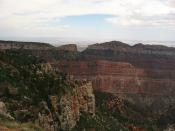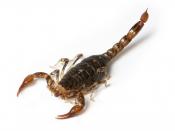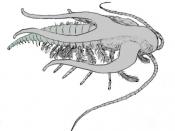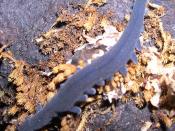On a recent trip to Hawaii, my colleagues and I had discovered a new class of arthropod inhabiting the volcano at Mt. St. Helens. We had decided to go vacationing in Hawaii as a learning experience to study the creatures inhabiting the volcano. While site-seeing, we spotted a strange type of creature crawling on a tree from where we stood. We decided to take a closer look and concluded that this creature happened to be in fact an arthropod because it shared all of the characteristics that normal arthropods have. Looking closer at this creature, we concluded that it didnÃÂt fit any of the classes of the three arthropod subphylums. We captured the arthropod so that we could study and try to classify this species.
A very special characteristic that this arthropod carried was the ability to breathe fire. My colleagues and I didnÃÂt understand how a creature of such stature was able to breathe fire.
After discovering the creatures, we spotted more creatures crawling down from the top of the volcano and heading to the forest. Since we never go anywhere without our scientific equipment, we took out and sent a robotic plane with a camera on its top to investigate where these creatures were coming from and why they were all exiting from the top of the volcano. Our discoveries led us to believe that these were definitely a new type of arthropod and they were able to live in extremely hot temperatures.
We had captured more of the creatures and took two of the creatures and put them both within a cage for further study. One of them was a male and the other was a female. Both of them had a total of 6 legs and 7 eyes. 2 legs were located on the head of the arthropod while the other 5 were located on the back of the body segment. However, the female possessed different characteristics than the male and behavior was one of them. It looked as if the female was asking the male to mate with her. After hours of research, the male finally succumbed to the femaleÃÂs wishes and then they mated and this was further studied as the mating process was very similar to other arachnids. The female laid eggs while the male fertilized the eggs.
More than a month was spent on the island and my colleagues and I had come up with a new class name for this arthropod. This arthropod was put within the Arachnid phylum because it possessed all the characteristics of an Arachnid. However, since it did not fit any of the existing classes of an Arachnida, we came up with our own and decided to call it the Flamapoda class. The scientific name for this species is constructed by using the binomial nomenclature and is called Araneus Flama, but is commonly known as the Volcanic Fire Spider.
It became clear to us that this island was their habitat and thanks to their exoskeleton, they are able to survive within temperatures that us humans would burn to a crisp in. The bodies of the arthropods have an octagonal shape and are green at the top and pink and the bottom. Also on top of the back of the Volcanic Fire Spider is a distinctive mark of three brown lines which some-what make up a triangle. The body segment in general is quite large in size while the 6 legs are skinny and long in size and are a light shade of green. Since the Volcanic Fire Spiders have such long legs, it makes them excellent tree climbers and also very fast. This is a good feature when trying to catch prey. While we were studying the arthropod, we noticed that it attacked other uniramians such as centipedes, millipedes and worms. This made it clear that it fed on carnivorous species. A unique characteristic of the Volcanic Fire Spider is the 5 eyes located on the back. This allows the spider to literally have eyes on the back of its body so that it can see not only frontwards but backwards. The mouth has two large spiky fangs that are used to capture itÃÂs pray and make sure that it doesnÃÂt go anywhere. Its life cycle was through gradual metamorphosis (young flamapede looks similar to adult but smaller in size). Also we noticed that eggs are laid by females in damp places or most commonly inside a hallow tree.
BIBLIOGRAPHY:1. http://www.britannica.com/EBchecked/topic/36943/arthropod2.http://evolution.berkeley.edu/evolibrary/article/_0_0/arthropods_01





